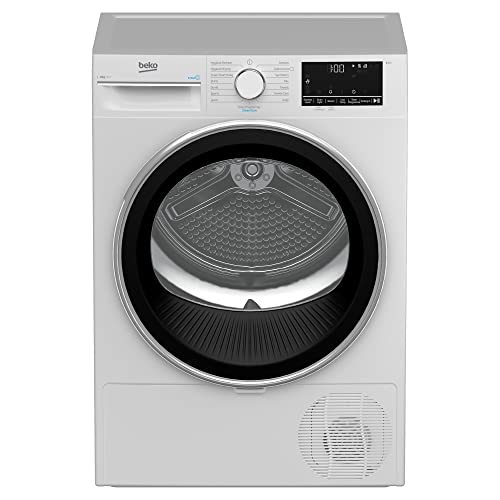Why Buy a Washer Dryer Heat Pump?
If you are seeking a complete washer/dryer think about a heat pump model. These ventless models take a little longer to dry and require more energy than traditional vented dryers, however, they are quieter and require no ducting or ventilation.
The machines use a heat-pump loop to circulate the air and recirculate water from the clothes back into the drain tube. Read on to learn more about the technologies behind these energy STAR certified machines.
Evaporative Drying
Evaporative drying utilizes hot air to evaporate water and remove the moisture from your clothes. It takes longer than dryers that utilize heat to speed up the process of evaporation however, as NYC moves towards half natural gas and more renewable energy sources over the next 10-20 years, you can expect to see an increase in dryer efficiency. In the case a washer dryer the heat is extracted from the air using electricity. This means that they use less energy than traditional dryers.
Heat pump dryers function like conventional dryers, but they have the components of a refrigeration system that provide air conditioning (evaporator and condensation). The refrigerant cycle's cooling segment is used to dehumidify dry air which then passes through the heat pump's evaporator. The dryer then re-heats the dry dehumidified air to provide drying heat.
This process produces a large amount of condensation water that needs to be disposed. This can be done manually, with a drain hose, or with a device that filters the water from the air flow to a laundry room sink or tub. Researchers have examined the effectiveness of heat pumps in drying processes. They have focused on assessing their performance in relation to dehumidification. A good method for this is exergy analysis. Exergy analysis compares the actual efficiency of a process with its ideal performance, which can be determined by determining the amount of energy needed to achieve the desired results in the process.
The ideal scenario is that the process generate energy that is greater than its input, however this isn't always possible especially with the case of a heat pump dryer. This is because the in the heat vaporization process can be included in the energy of the process of evaporation.
Researchers have investigated the performance of on a heat pump dryer through a computer simulation. This study suggests that the energy efficiency of the heat-pump dryer's efficiency is dependent on its dehumidification capacity and the temperature of the air in the evaporator, and the ratio between recirculating air and dry air.
Drying of Water Condensation
If you're looking for a method to dry your clothes more environmentally friendly than evaporative dryers, you can purchase washer dryer heating pumps that use water condensation. These units are usually more expensive, however they can be less expensive to run.
The majority of combination washer-dryers that utilize condensation drying work much like traditional tumble dryers, with the exception that they heat up the air that's taken out of the clothes and then cool it down so that the moisture in the air condenses back into water that is then drained away. The cooled air is then returned to the drum for more heating and further evaporation which repeats until all the clothes are completely dry.
The energy required by dryers like these is far smaller than traditional electric dryers or gas however, they're more than twice as expensive to run than standard dryers. The dryers have to heat a lot of the air before venting it outside.
This could be more than the energy saved by the unit itself, so these washer/dryers are best suited to homes with low energy costs.
If your laundry room has a window you can save more money by connecting the dryer directly to an outside drainpipe. This is referred to as ventless dryer.
If you opt for a dryer that has this feature, be sure to connect the hose properly. You'll find the connector for the hose at the bottom of the appliance. In most cases, you'll see a holder beside it. Take off the old hose and place the new hose in the holder. Be sure that the hose does not hang in the holder farther than 10cm, as this could cause it to become disconnected from the dryer and stop working.

Ventless Dryers
Ventless dryers are an excellent option for NYC homeowners who live in apartments or homes that aren't compatible with traditional vented dryers. The appliances are more energy-efficient and use less gas when compared to vented dryers. They save money over the long run. They are also smaller and don't require an external vent or duct. You can put an air-conditioned dryer in your laundry or anywhere in your home.
Ventless dryers dry clothes using two methods: air-toair condensation or cool-water condensation. They transfer heat from air to the clothes within the drum. This makes them more energy efficient than vented dryers.
Because they do not rely on the heat of the air to dry your clothes, they are more gentle on fabrics. This is important, as excessive heat can damage delicate fabrics and cause fade and color running.
Additionally it is true that a heat pump dryer is more efficient than condensing dryers in terms of energy use. This is because they use an evaporator, which absorbs the moisture in the air in the drum and transform it into water. visit the next post is a closed process, so there aren't any wastes.
It is vital to keep in mind that these appliances require regular maintenance in order to function optimally. They must be regularly cleared of any condensed water and cleaned of lint. Some models have a built-in reservoir that must be emptied regularly, whereas others connect to a drain in the plumbing system for automatic water disposal. To maintain the efficiency and effectiveness of the appliance the lint filter needs to be cleaned on a regular basis.
Energy Efficiency
It is natural that laundry rooms are looking for ways to cut down on their energy consumption, particularly when the cost of energy is so high and no relief in sight. The replacement of a standard dryer with a washer heat pump can drastically reduce energy costs and protect the environment.
These systems draw air from outside and use a refrigerant in order to draw heat from it. The air is then passed through heat exchangers, and then transformed into heat for drying clothes. This heat is transferred to the drum of the dryer, and is used to generate energy for the entire cycle. It also serves to heat water used for washing. The dryer then uses that hot water to drive the spin cycle, further reducing energy consumption and saving money.
The system operates in two closed cycles which are one for air and one refrigerant. The first cycle makes use of a fan that blows warm outside air over fins located on the cold side of the heatpump. This air absorbs heat energy, and is later carried away by coils located on this side. The air is then blown over the fins on the hot side in order to pick up more energy. This process continues throughout the drying cycle.
The air flows through a second, separate coil set on the cold end and becomes liquid when it is filled with heat. This liquid is then pumped through a compressor, which raises its temperature before turning it back to a gas. The liquid is then pumped through the dryer where it evaporates and dries clothes.
The dryer then blows out the hot air and reduces energy consumption by a significant amount. The remaining energy comes from the motor that runs the dryer's drum which consumes a tiny amount of energy at all times.
These units are up to 28 percent more efficient than traditional dryers that have an Energy Star rating around 4.3. This efficiency is due in part to the fact that they don't need a dryer vent and are able to operate at the same temperature as your central cooling and heating system. The absence of a vent for the dryer can also lower the cost of installation and increases the overall energy efficiency of your home.
